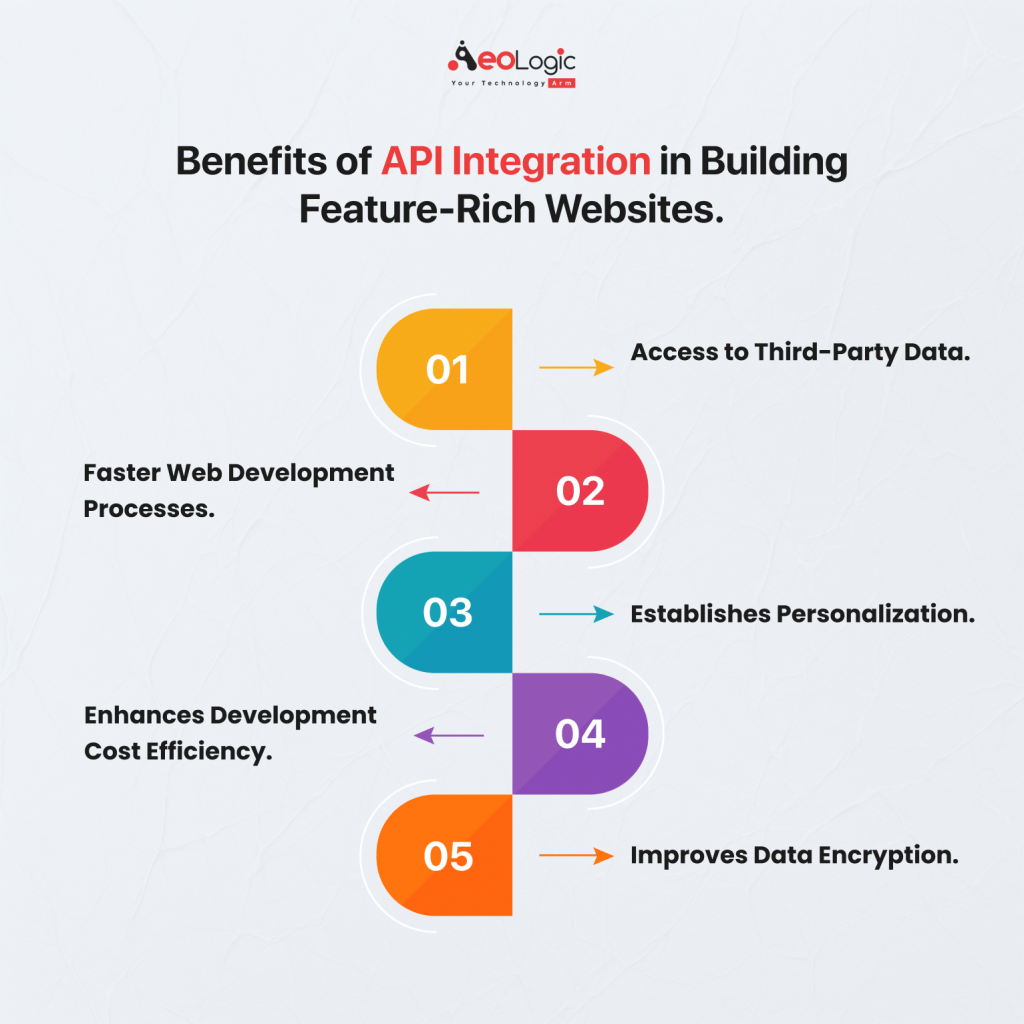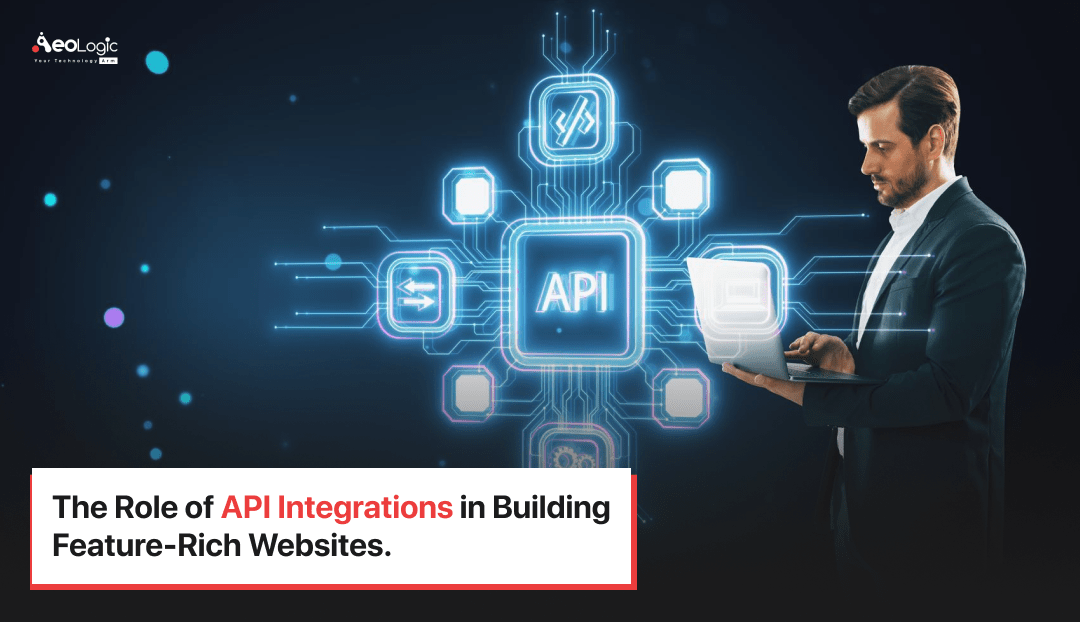Nowadays, websites are the most crucial aspects of every industry, as they provide information, services, data collection, data sharing, and the ability to connect people to the world. Websites are generally developed by software engineers, web development firms, etc.
The global web development market is estimated to be worth $74.69 billion in 2025. The market is expected to grow at a compound annual growth rate (CAGR) of 6.91% from 2025 to 2030, reaching $104.31 billion by 2030. These statistics should be enough to prove the existence of website development and the need for today’s digital world.
Overview
To remain competitive in the dynamic website development market, it’s essential to create feature-rich websites. However, traditional methods of website development often fall short when it comes to crafting innovative and seamless interfaces. To achieve this, incorporating something new and highly efficient into the development process is crucial—and that’s where APIs (Application Programming Interfaces) come into play.
APIs act as a bridge, enabling different software applications to communicate and work together seamlessly. By integrating APIs, developers can enhance websites with various advanced features without the need for manual coding or building these functionalities from scratch. This approach not only saves time but also ensures a more robust and user-friendly experience.
The global Application Programming Interface (API) market size is expected to be USD 1,027 million in 2025 and is projected to grow at a CAGR of 18.9% from 2025 to 2030.
The API economy is increasing rapidly as many software industries implement APIs to enhance their websites. This generally boosts the speed, features, efficiency, and seamless data sharing, enhancing a website’s functionality, performance, and user experience. Overall, APIs seem to be an important tool for taking web development to a new height of success.
We have seen the introductory part of the article, and we are going to see more additional details as we move forward. We will see some key benefits and challenges of API integration for web development. In the end, we will sign off with a concluding paragraph.
What is API Integration in Building Feature-Rich Websites?
Application programming interfaces (APIs) refer to the technology tools that implement connecting different software applications efficiently. There are many use cases of APIs, and web development is one among them. APIs can play many crucial roles in web development, as they enable feature-rich website development that could be more enhanced, immersive, and dynamic, with personalization options and smoothness like never before. There are many key benefits that we will see in the upcoming paragraph.
Also Read: Top Web Development Trends Every Business Should Watch
Benefits of API Integration in Building Feature-Rich Websites

API is one of the best tools in this digital world, and it surely possesses some benefits. Below are a few benefits of API integration in building feature-rich websites.
Access to Third-Party Data
Manual access to third-party data can be nearly impossible, and if possible, then it could be a time-consuming process. The API integration in websites makes it possible to access third-party data and also enables real-time visibility on websites like weather updates, stock market prices, news feeds, etc. With the API integration, websites can also display live videos and images via access to other social platforms.
Faster Web Development Processes
Web development is a long process as it needs to code, and research for perfect designs, interfaces, etc. Adding features or extra factors, it could take more time if done in the conventional ways. Where with the prebuilt of complex functionalities or features, developers can leverage APIs to implement sophisticated features quickly. This overall fastens the development process and reduces the time to market too.
Establishes Personalization
Personalization is a factor that every web designer wants to establish to offer a better experience to their users. But it is not fully possible to provide a personalized experience to users by manually analyzing their history. With the API, it is possible to provide personalized content on platforms like Netflix, Hotstar, etc., that enhances their overall experience. Basically, API integration enables dynamic, personalized, and real-time experiences for users on the web.
Enhances Development Cost Efficiency
Web development is affordable as the competition is high among the firms, but developing good websites rich in features can be costly. With the manual development process. With the conventional way of development, it is hard to integrate complex features from scratch, so that’s why it could be costly. But with the API integration, there is no need to develop complex features like payment processing, user authentication, geolocation, etc., from scratch. This saves money and time as it enhances the cost efficiency of development.
Improves Data Encryption
Data encryption is a crucial aspect for any business or operations and web development or uses involving various data from users. This is the responsibility of businesses to secure users’ data, like transactions, credit card numbers, their watch histories, checked history, etc. With the API integration to the web, it is possible to ensure secure data transmission through encryption protocols like HTTPS that ensure the safety and privacy of users’ data on the web.
Also Read: How Custom Web Development Enhances User Experience
Key Challenges to Watch Out for in API Integration
So we have seen the benefits of API integration, and now we have to see some challenges too. Here are a few challenges mentioned below.
- Insufficient authentication processes could be an issue with the API, as it does not have two-factor authentication.
- Depending on external software can be a challenging thing if the external API gets any error, then whole websites get affected.
- Encryption of data can be another issue, as sometimes external APIs can share data of users with external factors.
Related Blog: Top 10 Benefits of Outsourcing Web Development
Final Words
API is an incredible tool as it helps to access the complex features of websites with ease and in an efficient manner. There are many benefits to the integration of APIs into the web, as it can enhance data encryption, fasten the development process, provide better personalization features, provide access to external useful data, enhance cost efficiency, etc. It possesses some challenges too, like data privacy concerns, dependency, low authentication features, etc., but the benefits are that they are that good they cover up the challenges with a proper implementation process. Overall, APIs can make web development aspects better than ever by integrating a lot of complex features with so much ease and with better efficiency.
FAQs
How do I choose the right API for my website?
The first step in a successful API integration is understanding which features or services your site requires – whether that be payments, chat, maps, social logins, or data sharing. After identifying your site requirements, consider the following factors for vetting your API providers:
- Capabilities: Does the API include the functionality or capabilities that you require?
- Documentation: The better the documentation, the easier and quicker integration will be.
- Security: Look for secure authentication protocols such as OAuth 2.0 and HTTPS support.
- Scalability: Will the API accommodate your future growth based on user projections?
- Support and Community: Which API has the most engaged developer community and responsive support team.
- Reliability: Consider uptime history or service level agreements (SLA).
You can also compare a few API providers and experiment with their sandbox APIs; going into the full integration process with some validation is always positive.
What’s the difference between REST and SOAP APIs?
REST (Representational State Transfer) and SOAP (Simple Object Access Protocol) are two of the most widely used API communication protocols:
REST APIs are lightweight, flexible, and widely used in current web development, utilizing standard HTTP methods (GET, POST, PUT, DELETE). REST APIs are easier to use and are a more appropriate model for mobile and web apps.
SOAP APIs are more rigid in their definition and structure, relying on XML messaging, and are often used with enterprise or legacy systems where security, transactional integrity, and compliance are high priorities.
For your average use case on the web, a REST API would always be preferred due to speed, simplicity and compatibility with JSON.
Do API integrations affect SEO?
While API integrations do not directly impact SEO in terms of keyword rankings or metadata, they can provide indirect benefits to support SEO objectives:
- Page Speed Improvement: APIs can help a site handle less data load and facilitate serving dynamic content, resulting in better load speed relative to that content.
- Better User Experience: Integrations like live chat, personalized content, and recommendation engines can improve user engagement and decrease bounce rate.
- Freshness of Content: Real-time updates from APIs (e.g., weather, news, product feed) can help add current content to a website consistent with search engines’ preference.
However, API misuse can also create latency if not optimized. Developers should balance performance and functionality.
Can non-developers manage API integrations?
Some low-code or no-code platforms (like Zapier, Make, or certain CMS plugins) allow non-developers to integrate basic APIs, such as form submissions or CRM syncs. However, more complex integrations—like custom payment gateways, multi-step workflows, or APIs requiring authentication tokens—typically need:
- Basic understanding of web protocols (like HTTP requests)
- Ability to read API documentation
- Access to server-side code or development tools
In most professional projects, it’s advisable to involve a developer to ensure the integration is secure, scalable, and error-free.
How much does it cost to integrate APIs into a website?
API integration costs vary based on:
- Type of API: Certain APIs are free (e.g., OpenWeather, some Google APIs) and others charge based on request volume, user volume, or data volume.
- Complexity: Simple, plug-and-play APIs might only take a few hours to integrate. More complex APIs that require authentication or several endpoints or custom data flows could take days or weeks.
- Development resources: Freelancers may charge you by the hour or per project. Agencies can help with development and integration; they typically offer this service for a fixed-cost package.
- Maintenance costs: You need to think about what it will cost, in the long run, to monitor, test, update and troubleshooting the integration over time.
For a full-budget view, basic integrations will likely cost a few hundred dollars, while more advanced enterprise-level system integrations will cost from $2,000 – $10,000+.










